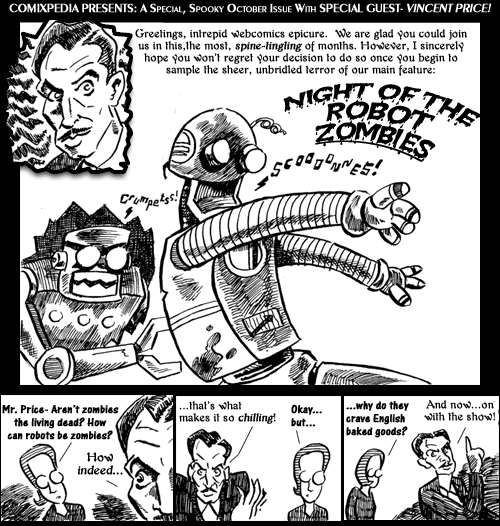October 2003 Cover

cover art by burke

cover art by burke
I’d like to take a little time to talk about creative ways to integrate text into comics. When I first started making webcomics, I didn’t give much thought to how the text would become part of my images. I drew the art, scanned it and typed in the words in the last stage of the production. This led to some very awkward passages in my webcomics.
Usually, text is used in speech balloons; sound effects; narration boxes and in very rare cases, the words become part of the image themselves. But sometimes artists stretch these standards to make something truly innovative in their work.
A friend of mine, reading my last article for ComixTalk ("A World of Fantasy"), wondered how I could write a whole piece on fantasy webcomics without mentioning Girl Genius by Phil and Kaja Foglio.
So I had to admit that it was only the artwork and some of the dialogue that got me through the very slow opening section of that comic. And just as I was finally gleaning enough information to get a feel for the character and the setting, they tear the character out of the setting and throw her down some place new. I’ve tried, but Girl Genius just isn’t for me.
Thinking about it, though, and with this summer’s Comic Con International still on my mind, I realized that several webcomics that I do read were also once published on paper. So here I am, writing about Girl Genius without actually writing about it so I can focus instead on Finder by Carla Speed MacNeil, Xeno’s Arrow by Greg Beettam and Stephen Geigen-Miller, and Galaxion by Tara Tallan.
In this month's Panels & Pictures, Derik A Badman makes a list of questions to consider when creating a comic: panel layouts? colors? composition? word balloons? Comics aren't simple when you start taking them apart.
Joel Fagin follows up his previous article on the selling of webcomics Reinventing Micropayments with another look at how creators could sell digital comics. This time, he further explores the notion of selling comic downloads and examines the initial results of Starline X Hodge’s sales of her comic Candi.
Last month, I complained that it was difficult to dig up enough stories to fill a full column for an “all ages†themed issue. I had no such problem this month! Of course, it’s no surprise that fantasy stories are plentiful in webcomics—fantasy comics have long been one of the most successful genres among independent print comics, from Elfquest, to Bone, to Finder. Fantasy creators continue to explore every inch of the genre, from philosophical, to action-packed, to erotic, to the downright silly.
Fantasy webcomics this month, is it? A large topic.
And we can make it even bigger. I mean, depending on how technical you wanna get, all fiction is fantasy. It’s stuff that never happened, at any rate, and that’s as basic a definition of fantasy as I can think of.
In this month's Panels & Pictures, Derik A Badman looks at a few long form webcomic narratives and how their serialization affects the reading experience.
Two lovers torn apart by a cruel world, plenty of swordplay, and giant robot spiders: Aya Takeo has all the ingredients of classic manga. But will it get people talking? Continue Reading

Cover art by Gisele Lagace.
Recent Comments